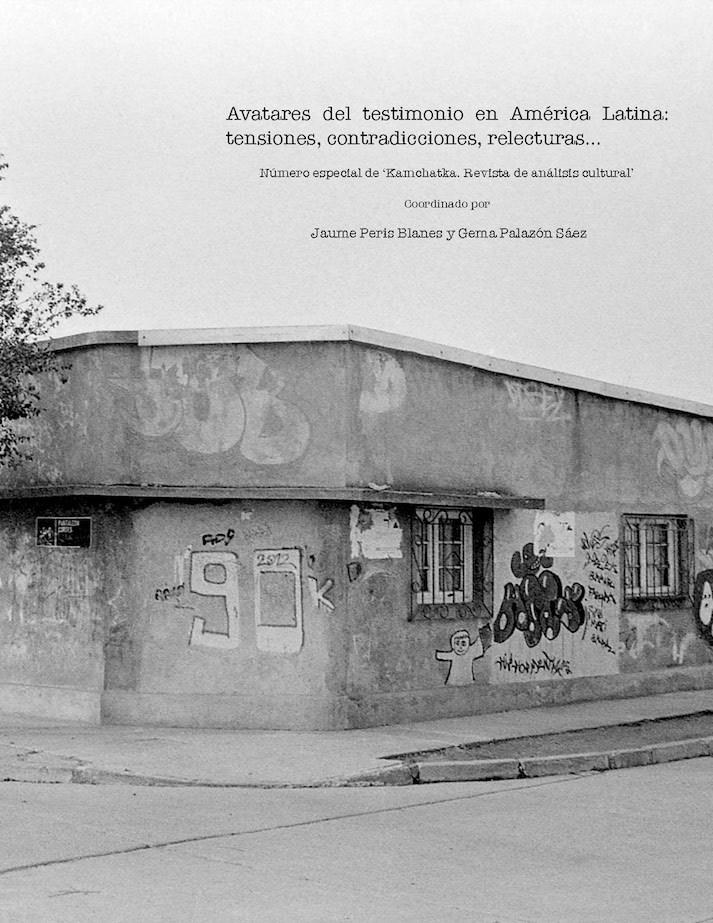Figuras de justicia. El testimonio en los documentales sobre los juicios por los crímenes de la última dictadura militar argentina
DOI:
https://doi.org/10.7203/KAM.6.6320Keywords:
Juicios, Testigo, cine documental, Argentina, dictadura Abstract
Abstract
Resumen: En Argentina, desde el 2006 hasta la fecha, han tenido lugar más de cien juicios por los crímenes cometidos durante la última dictadura militar argentina. El presente trabajo, de carácter exploratorio, tiene como objetivo analizar algunas de las producciones documentales sobre los mencionados juicios. Para llevar adelante nuestra tarea, tomaremos la noción de “figura de justicia” pensada por la criminóloga Nicole Rafter en su estudio sobre el cine de juicios, como también las ideas de Annette Wieviorka en torno a la era del testigo. Con ello, indagaremos el lugar del testigo y del testimonio para pensar qué tipo de narrativa de memoria promueven los documentales.
Palabras Clave: Juicios, Testigo, Cine Documental, Argentina, Dictadura.
Abstract: In Argentina, since 2006 to date, there have been over one hundred trials for the crimes committed during Argentina's last military dictatorship. The present paper aims to analyze, in an exploratory way, some of the documentary productions about these historical trials. To carry out our task, we will take the notion of “figure of justice” thought by the criminologist Nicole Rafter in her study about cinema and crime, as Annette Wieviorka’s ideas about the age of the witness. With this, we will investigate the place of the witness and the testimony in order to think what kind of narrative memory these documentaries promotes.
Key Words: Trials, Witness, Documentary Cinema, Argentina, Dictatorship.
 Downloads
Downloads
 References
References
Bibliografía citada Agamben, Giorgio (2000). Lo que queda de Auschwitz. El archivo y el testigo. Valencia: Pre-Textos. Aguilar, Gonzalo (2007). “Maravillosa melancolía. Cazadores de utopías: una lectura desde el presente”. Moore, María José y Wolkowicz, Paula (edas.). Cines al margen. Buenos Aires: Libraria: 17-32. Aprea, Gustavo (2008). Cine y políticas en Argentina. Continuidades y discontinuidades en 25 años de democracia. Buenos Aires: Biblioteca Nacional. Baer, Alejandro (2005). El testimonio audiovisual. Imagen y memoria del Holocausto. Madrid: CIS/Siglo XXI. Berizonce, Roberto Omar y Martínez Astorino, Roberto Daniel (2013). “Los juicios orales en la Argentina”. Ferrer Mac-Gregor, Eduardo y Saíd Ramirez, Alberto (eds.). Juicios Orales. La reforma judicial en Iberoamérica. México: Instituto Iberoamericano de Derecho Procesal, UNAM: 39-65. Delage, Christian (2013). Caught on Camera. Film in the Courtroom from the Nuremberg Trials to the Trials of the Khmer Rouge. Philadelphia: University of Pennsylvania Press. Feierstein, Daniel (2015). Juicios. Sobre la elaboración del genocidio II. Buenos Aires: Fondo de Cultura Económica. Feld, Claudia (2002). Del estrado a la pantalla: Las imágenes del juicio a los ex comandantes en Argentina. Madrid: Siglo XXI. Frodon, Jean-Michel (2010). “The Work of the Filmmaker: An Interview with Claude Lanzmann”. Frodon, Jean-Michel (ed.). Cinema & the Shoah. An Art Confronts the Tragedy of the Twntieth Century. Albany: State University of New York Press: 85-98 Huyssen, Andreas (2001). En busca del futuro perdido. Buenos Aires: Fondo de Cultura Económica. Jelin, Elizabeth (1995). “La política de la memoria: el movimiento de derechos humanos y la construcción democrática en la Argentina”. AA.VV. Juicio, castigos y memorias. Derechos humanos y justicia en la política argentina. Buenos Aires: Nueva Visión: 101-146. Kaufman, Ester (1990). “El ritual jurídico en el juicio a los ex comandantes. La desnaturalización de lo cotidiano. Guber, Rosana (eda.). El salvaje metropolitano. Buenos Aires: Legasa: 328-357. Lemkin, Raphael (2009), El dominio del Eje en la Europa ocupada. Buenos Aires: Prometeo. Maniga, Giancarlo (2011). “Los Juicios en Italia”. Andreozzi, Gabriele (ed.). Juicios por Crímenes de Lesa Humanidad en Argentina. Buenos Aires: Atuel: 119-133. Mèlich, Joan-Carles (2001). La ausencia del testimonio. Ética y pedagogía en los relatos del Holocausto. Barcelona: Anthropos. Oberlin, Ana (2011). “El proceso de justicia desde la mirada de una abogada representante de víctimas y militante de H.I.J.O.S”. Andreozzi, Gabriele (ed.). Juicios por Crímenes de Lesa Humanidad en Argentina. Buenos Aires: Atuel: 199-216. Rafter, Nicole (2000). Shots in the Mirror. Crime Films and Society. New York: Oxford University Press. Renov, Michael (1993). “Toward a Poetics of Documentary”. Renov, Michael (ed.). Theorizing Documentary. New York: Routledge: 12-36. Ricoeur, Paul (1983). Texto, testimonio y narración. Santiago: Editorial Andrés Bello. Sikkink, Kathryn (2013). La cascada de justicia. Cómo los juicios de lesa humanidad están cambiando el mundo de la política. Buenos Aires: Gedisa. Todorov, Tzvetan (2008). Los abusos de la memoria. Barcelona: Paidós. Wieviorka, Annette (2006). The Era of Witness. Ithaca: Cornell University Press. Wieviorka, Annette (2010). “The Filmed Witness”. Frodon, Jean-Michel (ed.). Cinema & the Shoah. An Art Confronts the Tragedy of the Twntieth Century. Albany: State University of New York Press: 191-204.
Downloads
Published
How to Cite
-
Abstract1798
-
Artículo (Español)652
Issue
Section
License
This journal provides an immediate free access to the content on the principle that freely make investigation available to the public, which promotes an increased global knowledge exchange.
Unless otherwise indicated, texts published in this journal are under the license Attribution-NonComercial 4.0 by Creative Commons. These texts may be copied, distributed and publicly communicated whenever the publication’s author and title are quoted and whenever they are not used for commercial purposes. In any case, intellectual property of the articles and its potential economic rights entirely belong to its authors.
The full license can be consulted on https://creativecommons.org/licenses/by-nc/4.0/. We encourage authors to disseminate papers published in Kamchatka. Journal of cultural analysis electronically, in institutional digital repository or in their websites.





